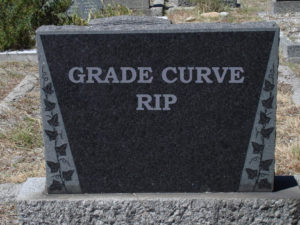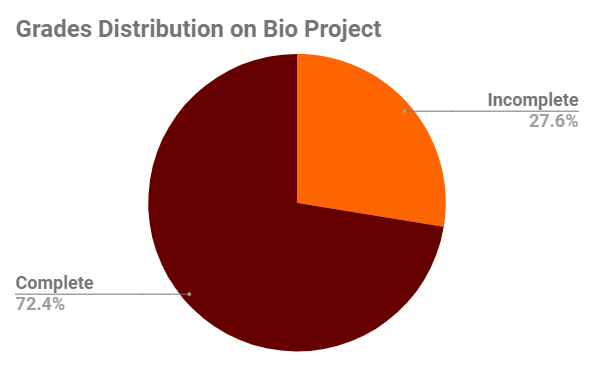A lot of you told me in your midterm evaluation that you were anxious about the grading system in these ways:
- Some of you worried about how well you were doing on the portion of your grade that would mean that you earned a grade higher than a B in the course.
- Several of you used a form of the word competition to describe how you felt about the course because of the curve that is mentioned on the syllabus.
- Some have commented that you aren’t sure how you are doing in the course because of the unusual grading system.
About the Grade Curve
Your worries about the grade curve concern me for several reasons:
- If you are anxious about the course, you aren’t able to focus on doing your best work.
- This labor-based grading system is intended to make you feel free to take risks and revise as much as you like—it’s meant to make you less anxious, not moreso.
 I did some additional reading on the kind of Complete/Incomplete, no-grades system that I am using, and I found this comment on Jesse Stommel’s blog: “Grading on a Curve: In brief, it pits students against each other, discourages collaboration, and privileges the students who our educational system has already privileged.”
I did some additional reading on the kind of Complete/Incomplete, no-grades system that I am using, and I found this comment on Jesse Stommel’s blog: “Grading on a Curve: In brief, it pits students against each other, discourages collaboration, and privileges the students who our educational system has already privileged.”
As a result, the statement on the Requirements page that “Grades higher than a B will be based on a bell curve” will not be used in this course. The passage is marked out on the page. The difference between a B+, A-, and A are still related to the value of your contributions and how they demonstrate your leadership and add support to the writing community; however, you will not be compared to any other student.
About Your Grade in the Course
I posted details on How Canvas Grades Work, which I intended to help you tell how you are doing in the course. That information does seem to be adequate, so I want to try something new.
I have created three completion checklists for the course:
By completing these checklists (quizzes in Canvas), you will tally up how you are doing in the course. There are 100 points for each week, for a total of 1500 point overall.
These checklist quizzes are totaled automatically. You can complete them as many times as you like so you can keep a running tally on work in progress.
Because of the way the Canvas gradebook works, I cannot make the points total properly. You will have to add the scores on the three checklists yourself. Divide the number of points you accumulate by the number of points possible to get an idea of your grade in the course. Here’s an example:
- The midterm checklist is worth 700 points.
- If you did not do any extra work toward a B and you missed one labor log, you would accumulate 586 points.
- 586/700 = 83.7 (so you are close to a B in the course)
The checklists are based on the assumption that if you turn in your major projects, you will eventually earn a Complete on that work. You must earn a Complete on all five major projects to earn a B or higher in the course.
About Your Final Exam
The completion checklists are a simple way for you to keep track of the work that you have done in the course. You can use the points from the checklist as you write your Final Exam, in which you propose the grade you should receive in the course.
The final exam and its purpose in the course are NOT changing. The numbers from the checklist will give you a general idea of where you stand, but your actual grade in the course will be based on how effectively you present your argument in your final exam.
Remember that the numbers from the checklist are a guideline only. You explain how I should read those numbers when you write your final.
Questions?
If you are confused or want to respond to these changes, you can leave a comment on this post.
Photo Credit: Tombstone: What up Holmes by Warren Rohner on Flickr, used under a CC-BY-SA 2.0 license.
Last updated on Sunday, March 25, 2018
 I did some additional reading on the kind of Complete/Incomplete, no-grades system that I am using, and I found this comment on
I did some additional reading on the kind of Complete/Incomplete, no-grades system that I am using, and I found this comment on  I have graded all of the Professional Bio projects. This post accomplishes the following goals:
I have graded all of the Professional Bio projects. This post accomplishes the following goals:  I believe that a system that allows you to keep working until you get the results that fit the workplace is more humane than a system that punishes you if you aren’t perfect on the first try.
I believe that a system that allows you to keep working until you get the results that fit the workplace is more humane than a system that punishes you if you aren’t perfect on the first try.  I have worked in quite a few places, and in none of them did I ever receive a letter grade for the work that I did. Never ever. It just doesn’t work that way.
I have worked in quite a few places, and in none of them did I ever receive a letter grade for the work that I did. Never ever. It just doesn’t work that way. I adapted this strategy from Asao Inoue’s work on
I adapted this strategy from Asao Inoue’s work on  The most important benefits of this system are explained in the
The most important benefits of this system are explained in the  Work in this class is either ready to use in the workplace (and graded Complete) or it’s not ready (and graded Incomplete).
Work in this class is either ready to use in the workplace (and graded Complete) or it’s not ready (and graded Incomplete). You document the time you spend on activities and the level of intensity you put into your work in your labor log. You can think of tracking your work in your log as a parallel to tracking billing codes for what you do in the workplace.
You document the time you spend on activities and the level of intensity you put into your work in your labor log. You can think of tracking your work in your log as a parallel to tracking billing codes for what you do in the workplace.  In the workplace, you will find yourself reading and commenting on the projects of your coworkers frequently. The peer feedback activities in our class give you the chance to learn more about that process. Writing in the workplace is as much about what you write as it is about how you help others with their writing.
In the workplace, you will find yourself reading and commenting on the projects of your coworkers frequently. The peer feedback activities in our class give you the chance to learn more about that process. Writing in the workplace is as much about what you write as it is about how you help others with their writing. I have graded all of the 1/26 Labor Logs. Good news: Everyone who turned in a log earned a Complete!
I have graded all of the 1/26 Labor Logs. Good news: Everyone who turned in a log earned a Complete! There have been some questions about the grades posted tonight for the
There have been some questions about the grades posted tonight for the  I have graded all of the 1/19 Labor Logs. In this post, I’ll comment on how you all did and what you can do if you are not happy with your grade. Please read the information carefully and note the related dates.
I have graded all of the 1/19 Labor Logs. In this post, I’ll comment on how you all did and what you can do if you are not happy with your grade. Please read the information carefully and note the related dates.